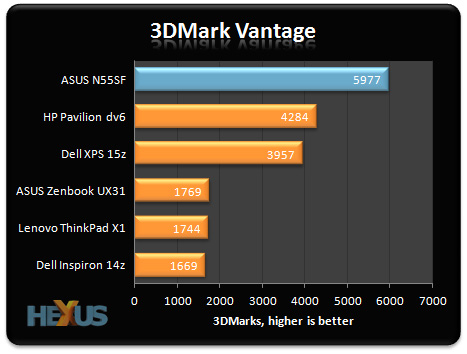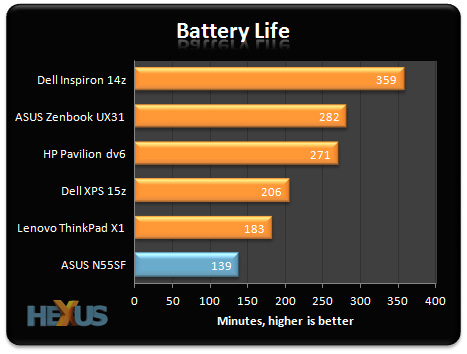Performance - Part Two
GPU Performance

For the laptop's graphics needs, ASUS has expanded upon the integrated Intel GPU with the addition of a dedicated NVIDIA GeForce GT 555M. The NVIDIA chip is clocked at 675MHz, features 144 shaders and is complimented by a 2GB DDR3 frame buffer clocked at 900MHz.
It provides full support for DirectX 11, and based on the 3DMark 06 results, it should deliver acceptable frame rates in many of today's games.

The 3DMark Vantage results are similarly impressive, with the ASUS N55SF's GeForce GT 555M easily outperforming the HP Pavilion dv6's Radeon HD 7470M and the Dell XPS 15z's GeForce GT 525M.
Both the CPU and GPU are strong performers, but how do these synthetic results translate to real-world games? To give you an idea, we ran Just Cause 2 at the laptop's native 1,600x900 resolution and returned a silky-smooth framerate of 50 frames per second with low image-quality settings (0xAA, 2xAF). Increasing image quality to medium with 2xAA and 8xAF lowered performance slightly to 42 frames per second, and at high quality (4xAA, 16xAF) the laptop continued to churn out in excess of 33 frames per second.
There's certainly a good amount of gaming potential on offer here, and the vibrant display and excellent sound system combine to create a thoroughly enjoyable mobile gaming experience. Though, you wouldn't necessarily want to game with the N55SF on your lap - during testing, we found that the system can become uncomfortably warm when the GPU is in use for long periods.
System Performance

PCMark 7 provides a look at overall system performance by utilising varying workloads that stress the system's vital components - including the processor, graphics chip and storage device.
The latter plays an important part in this benchmark, and with a hard-disk that operates at a basic 5,400RPM, ASUS's N55SF - despite featuring strong CPU and GPU components - drops into the bottom half of the chart. The laptop is still quick during everyday use, but it's a long way off the responsiveness of an SSD-equipped machine such as the Zenbook UX31.
Putting a real-world slant on these findings, we found that the Zenbook UX31 Ultrabook was able to boot into Windows 7 in under 20 seconds, compared to an average of 56 seconds on the N55SF Laptop.
Power Consumption and Battery Life

There's a downside to having both a powerful CPU and a powerful GPU in the same machine, as this high-performance combination forces the ASUS N55SF to consume more power than the average laptop.

As always, power consumption is directly related to battery life. Finish top of the previous chart, and you'll often finish bottom of this.
The poor runtime is not entirely unexpected, but under two-and-a-half hours of video playback is disappointing nonetheless, and it proves to be the N55SF's one major Achilles' heel.









